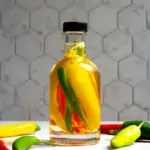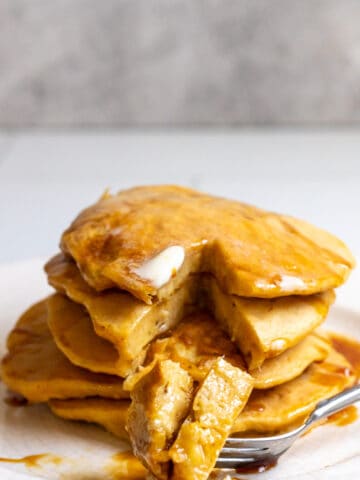Love hot sauce? This easy hot pepper vinegar is a homemade hot sauce made with fresh chili peppers infused in vinegar.

Did you grow hot peppers this year?
I grew habaneros, serranos, jalapeños, poblanos, and burrito peppers.
And guys, I love hot peppers.
Whenever I see varieties of hot peppers that I haven't tried (or haven't tried recently), I buy them. Even though I probably already have lots of hot peppers in my crisper drawer.
Each summer, I make a few batches of my favorite homemade hot sauce (enough to last us until the next summer).
Earlier this year, my friend Bobbie mentioned that she was making a different type of hot sauce, hot pepper vinegar. Since I already make lots of other infused vinegars (like basil vinegar and chive blossom vinegar), I wanted to give this a try too!
It was the easiest hot sauce I've ever tried.
This easy hot pepper vinegar is made with vinegar and chili peppers, and is a delicious homemade condiment.
If you've got lots of peppers to use, try making fire-roasted salsa, mango habanero salsa, and vegan tortilla soup! Or freeze them for later.
Types of Hot Pepper Vinegar Infusions
Bobbie was making Puerto Rican pique, a version of infused pepper vinegar that's traditionally made with ajíes caballeros (Puerto Rican hot peppers) and a variety of other seasonings (like garlic and pineapple).
This hot pepper vinegar is a simplified version of Southern-style peppa' sauce, and is based on a recipe in The No-Waste Vegetable Cookbook. It's the easiest version of any pepper sauce recipe I've seen yet.
All you need are chili peppers and vinegar. That's it!

What Kind of Vinegar Should I Use?
I like to use white wine or champagne vinegar for infusions.
You could also use apple cider vinegar; just be aware that it does have a stronger flavor. Also, since apple cider vinegar is brown and cloudy, it will affect the color of the finished vinegar.
If you want to use homemade vinegar (like homemade apple cider vinegar) or rice vinegar, you should infuse your vinegar in the fridge and expect the infusion to take longer than the recipe indicates.
Homemade vinegar (generally) has an unknown acidity level, and rice vinegar has an acidity level below 5%. If you’re infusing either with “wet” ingredients like fresh peppers, keep it cool to avoid bacteria growth.
I don't recommend using distilled white vinegar because it has a strong astringent flavor.
What Kind of Peppers Should I Use?
Use your favorite peppers or whatever peppers you have on hand. I love making this sauce with serrano peppers or cayenne peppers.
Keep in mind that the hotter your peppers, the hotter your final sauce will be.
If you've ever tried Louisiana pepper vinegar, it's made with tabasco peppers.
Do I Have to Refrigerate This Vinegar?
No, but it will last longer if you do.
Plan on the vinegar lasting about three months at room temperature, or six to eight months in the fridge. So whether or not you refrigerate it really depends on how quickly you'll use this vinegar.
How Many Hot Peppers Do I Need?
It's really up to you.
I recommend using at least three peppers, or as many as twelve. Alternatively, you can simply fill whatever glass jar you're using with as many peppers as possible.
The amount of peppers you use will depend on how large the peppers are, how hot the peppers are, and how hot you want the sauce to be. If you're using very hot peppers (like habaneros), you might want to use fewer peppers.
How to Make Hot Pepper Vinegar
Start by rinsing off your hot peppers.
For a milder vinegar, cut a slit in each pepper. For hotter vinegar, slice the peppers in half.
Place the peppers in a clean glass jar.
Warm the vinegar and pour it over the peppers. Seal the jar and set it out of direct sunlight to infuse.
Alternatively, you can skip heating the vinegar for a cold infusion. The infusion will take longer, but the flavor will be slightly more delicate.
How Long Should I Let the Hot Peppers Infuse?
Infuse until you like the flavor, and then start using it!
I recommend letting it sit for at least two days.
Once you like the flavor, you can strain out the peppers (if you want to), or leave them in the bottle to continue infusing. I like to leave the peppers in the bottle!
How to Use Hot Pepper Vinegar
Traditionally, Southern-style pepper vinegar is used on cooked greens like this slow-cooker kale.
It's also delicious on boiled eggs, potatoes, or anything you'd normally top with hot sauce!

Hot Pepper Vinegar
Ingredients
- 3-12 hot chili peppers, depending on size + heat level Use fewer peppers for a milder vinegar. I like to fill whatever container I'm using with peppers.
- 1 cup white wine vinegar OR champagne vinegar
Instructions
- For a milder vinegar: Cut a slit in each pepper.For a hotter vinegar: Slice each pepper in half, leaving the seeds and membrane.Optional: Heat the vinegar until it's warm. Do not bring it to a boil.Tip: Heating the vinegar will help the peppers infuse more quickly, but will produce a slightly less delicate flavor than room temperature vinegar.

- Add the peppers to a clean glass bottle or jar.Pour the vinegar over the peppers into the bottle until almost full. (The amount of vinegar listed is approximate; you may need slightly more or less.)Seal the bottle, and place it in a cool place out of direct sunlight. Allow the peppers to infuse for at least 2 days (if you used warm vinegar), or 2 weeks (for room temperature vinegar), until you like the flavor, and then use the vinegar as desired.Optionally, strain out the peppers. I keep the peppers in mine and allow the vinegar to continue to infuse. Store at room temperature for up to 3 months or in the fridge for 6-8 months.

Notes
Use the measurements as a guide, not a rule. If you use more peppers your infusion will be stronger, and fewer peppers will give you a milder infusion. Vinegar Substitutions:
I recommend using white wine or champagne vinegar. If all you have on hand is apple cider vinegar, it will work, but it does have a stronger flavor profile. If you use rice vinegar, you should infuse the vinegar in the fridge and expect the infusion to take slightly longer. Rice vinegar's lower acidity level makes it unsafe to infuse at room temperature. Avoid using white distilled vinegar, because it's too astringent-tasting. Troubleshooting: If your vinegar becomes slimy, develops mold, or smells off, toss it. If it begins to show signs of fermentation (bubbling), toss it.







Sally A. DeHart
I’m growing organic, chili tepins. I’m going to try pickling some using your recipe. Chili tepins are about the size of a pea to a blueberry. Native to the Sonoran Desert, they are as hot as the climate, perfect for spicing up frijoles, meats and sauces.
Missing my hometown I brought back seeds and have been growing them in pots in my garden. Because I live in Bend, Oregon and it snows I bring my plant inside during the winter. If you’d like me to send you some, I’ve got plenty of chilies.
Alisha Trenalone
Hope you have success making this with the chili tepins! That sounds really neat 😊
-Alisha at Champagne Tastes
Sabrina
Hot pepper vinegar has been a staple in every Southern household for generations! My mama had a jar of it that she just kept on adding more vinegar to as it got low, and pulled out old chili's and stuffed in new ones. Same Texas Pete jar was in our refrigerator door as long as I can remember opening it to look for the tomatoes and mayonnaise.
Alisha Trenalone
It's a great use for those peppers!!
-Alisha at Champagne Tastes
Kati Brown
can I use peppers I have had frozen? I've made this with fresh ones and it was fabulous, I have a ton of frozen peppers and would like to use them in this, but not sure if it'll work. thanks!
Alisha Trenalone
Hi Kati! We haven’t tried that before, but don’t see why not!
-Alisha at Champagne Tastes